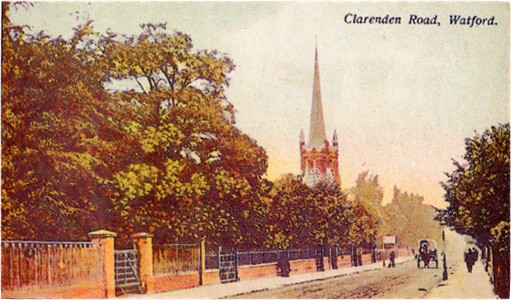DUDGEON, Watford, from 1891
January, 2005
The family may well be connected to J & W Dudgeon who were London shipbuilders and who built a number of blockade runners for the Confederate government during the American Civil war.

Clarenden Road in about 1906 - with the
Congregational Church
From a Watford
Observer Supplement - The Millenium Collection, 1900-1924
First a little detail about the family. The 1891 census show Arthur Dudgeon (52, civil engineer, contractor & surveyor, born Bloomsbury, London) as head of a clearly well to do household, with a bevy of servants. The children were all born in Ireland, and as the youngest is only 1 year old it is obvious why he is not listed as living in Watford in the 1890 Kelly's directory for Hertfordshire. However he is listed as a private individual in the 1895 and 1902 directories, while Mrs Dudgeon is listed at the address in 1908 and 1912. Presumably Arthur had died at somewhere about the age of 65.
A comment about Clarendon Road is appropriate. Prior to the coming of the railway Watford was a long busy High Street and virtually nothing else. Clarendon Road was opened in 1864 (Street and Place Names in Watford) to provide a link between the High Street and Watford Junction railway station. This opened up prime residential building land - and as the picture shows (or rather does not show because they are hidden by the trees) - expensive houses were built for well-to-do commuters. What more convenient than a five minute walk to the railway station where one could get a first class seat to London. Houses would have been given names by their owners, and if you moved into a house and didn't like the name you would change it. Initially there would have been no question of allocating numbers - as in any case living in a house with a number would be seen as rather infra-dig.
The most likely picture is of an established professional gentleman, with no previous links with Watford, who moves to Watford in his early 50's because he works in London and there is a good rail service. He lives in an expensive location, close to the railway station, where there are many similar people who also treat Watford as a convenient dormitory town. He dies in his 60s, possibly while still working in London. Then, as now, few elderly commuters had sufficient energy and enthusiasm for the place where they live to make much impression on the local community, where, for example, most people who became town councillors would have long living and working associations within the town.
In these circumstances it is not really surprising that there is no mention of the name Dudgeon in the Nunn's The Book of Watford, which is the most likely general history of the town to mention Arthur. Of course he may have been active in some local organisations, perhaps the Congregational church in Clarendon Road that can be seen in the above photograph. If you visited the Local Studies section of Watford Central Library (see HCC site for contact details) you might find something - although I can tell you now that he is not listed as a member of the Watford Masonic Lodge (A Short History of the Watford Lodge No 404, 1829-1929). It is likely that he made donations to some local bodies, such as the Hospital, or attended a charity concert, and sometimes local newspapers gave a list of people donating/attending.
By far your best bet would be to see if any of the local newspapers published an obituary when he died - at that would be sure to mention any significant local links. If you have details of his death it is possible that the Watford Central Library might be able to look it up on their microfilm of the Watford Observer. His funeral might also be described, and could list people attending. If there are no local obituaries or funeral reports you could assume his impact on the town was not significant.
I would be interested to know if the will and obituary (if any) provide valuable additional information about Arthur's involvement in Watford.
There is a web page for Watford
If you can add to the information given above tell me.